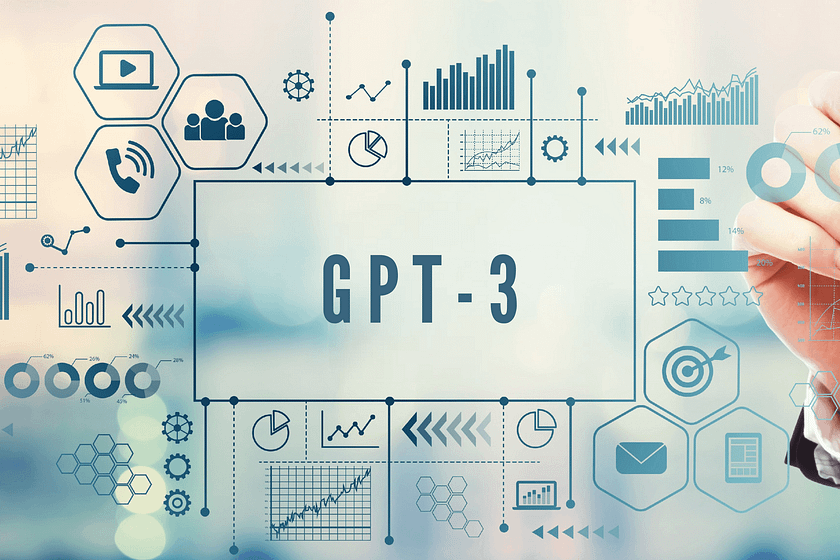Even though the development of AI has been a hot topic for a few years already, lately, it has gotten even hotter thanks to the debut of AI-powered ChatGPT (by OpenAI). As you are probably well aware, the chat is open to the public, so everyone can test its possibilities for free — which, I must admit, is a smart move of its creators. They didn’t really need to advertise it or even explain how it works, as it’s perfectly able to explain (and prove) itself — literally. So it’s no surprise that many quickly fell in love with it.
Now, LinkedIn is bursting with posts about the chat and the technology lying at its core: the GPT-3. And everyone is wondering: how else can we use this fine smart AI model? How could it be implemented in various industries and business areas to make our work easier, faster, and more effective? Can we use it to simplify and speed up processes, streamline operations and provide higher-quality services to our customers?
That’s what I’ve investigated to share with you in this piece!
PS Along with the use cases, I also linked some examples of already existing GPT-based solutions so that you can see what’s already out there.

Hi, my name is Generative Pre-trained Transformer 3
GPT-3 — Generative Pre-trained Transformer 3 — is a natural language prediction model developed by OpenAI. It was launched already in June 2020, but even though it gained such vast publicity only lately, it’s already been adopted by hundreds of businesses. To give you a better idea: it hit over 300 applications within barely nine months of its launch. And now, thanks to the boom started by ChatGPT, it’s on everybody’s tongues — and I think it won’t be an exaggeration to say it’s taking the 2023 tech scene by storm.
It’s the first language model of this kind we have ever been able to lay our hands on. It can generate text which is basically indistinguishable from that written by a human being — and everything indicates it will be getting better and better. These abilities make it great for building tools for various industries and business areas, such as customer service, marketing, and programming, to name a few.
GPT-3 processing limitations
Just one more thing before we jump into the use cases. GPT-3 has one limitation you should keep in mind. For now, it’s able to analyze and produce text only up to 4096 tokens, meaning around 3000 words. Precisely, one token translates into roughly 4 characters. To simplify the calculations, it’s assumed that one token is approximately 0.75 words. What’s also important here is that this limit refers to the prompt and output together (so all the tokens “used” within a single request).
What does it mean, exactly? Simply put, if you provide the model with a text or document consisting of over (or, depending on the length of the words, even close to) 3000 words, it won’t be able to process it fully and will return an error. In turn, if your prompt is, let’s say, 1500 words long, there are only ~1500 words left for the model to generate the output because once the number of tokens within a single request (the prompt and the output together) reaches the limit of 4096, the model won’t be able to generate anything further.
So, as for now, if you ask the model to analyze a big pile of documents or a book and to, let’s say, prepare a summary — it won’t be able to process such a request. It’s worth underlining, though, that these numbers will most probably grow as the model is further developed.
UPDATE [23.02]: According to the screenshots of documentation published to Twitter by users with early access, OpenAI is getting ready to release their new offering called Foundry. One of the text-generating models listed in the pricing chart had a 32k max context window, which means increasing the tokens limit by 8 times!
Read also: Open-source vs. OpenAI. 8 best open-source alternatives to GPT

In the recent OpenAI product update (March 14, 2023), we could read about the new GPT-4 models, which seem to be the equivalents of the DV (8K max context) and the DV (32K max context). Even though their cost is much higher than the cost of using GPT-3 and GPT-3.5 models, the potential for new use cases that they create is huge!
In this article, though, let’s focus on the GPT-3. With that being said, let’s get to the use cases!
GPT-3 in customer service
GPT-3 presents itself as a great candidate for powering customer service tools. Using it, you can build a highly efficient chatbot, autoresponder, and even a personal assistant. Let’s take a closer look at each of those.
GPT Live chat/GPT chatbot
As it’s already been proven by ChatGPT, GPT-3 can help you build an impressive chatbot that will be available for your customers 24/7 and, if necessary, in various languages. A well-trained model can be able to accurately understand your customers’ queries and provide them with clear, comprehensive answers — even to follow-up questions. Thanks to that, you can provide your clients with a reliable, instant source of information, whether on new services they might be interested in or solutions to problems they may face.
Personal assistant
This one could be an extended version of the chatbot. A personal assistant that’s there for the customers whenever they need it, ready to not only answer their questions but also assist them in certain tasks. You name it. It could be setting up something in your app or achieving some goal within the capabilities of your tool that requires following a specific path. Or planning their trip by, e.g., suggesting destinations covering their requirements, researching the best places to stay, and even taking them through the reservation process. Possibilities are vast — it all depends on the services your business provides.
Autoresponder
Let’s say you want to add feedback to every customer review you get. It’s not a mystery that generic replies annoy people and are not the best way to build strong, positive relations. And in the case of… not entirely positive reviews, generic responses can even jeopardize your relationship with the customer or, in the worst case, escalate the problem.
Here’s where a GPT-based autoresponder comes to the rescue. The model can analyze both the received review and information about the customer in your database (e.g., what products or services they ordered, whether they added some special requests, etc.) and prepare a well-fitted, logical reply in a tone of voice adjusted to the one you use in your communication.
Existing examples of GPT-3-based customer service tools:
- Quickchat.ai — a solution for building human-like virtual assistants
- Messagebird — an omnichannel automation platform
- Replier.ai — a customer review responder
Read also: How does artificial intelligence improve customer service?

GPT-3 in personalized recommendations
There are already plenty of apps (e.g., Netflix, Amazon, Spotify) providing users with personalized recommendations based on their individual preferences, behavior, etc. A well-trained GPT-3 model could boost the accuracy of such recommendations by analyzing not only those “basic” factors but also deepened ones, such as users’ goals or the context and meaning of the user’s previous activity. All this, naturally, can translate into improving your customers’ satisfaction and increasing sales.
So, what could the model recommend? From exercises, music, and movies, to hotels and products to buy, to name a few. Remember, though, that the accuracy of such a solution — the same as in the case of every other GPT-3 application — strongly depends on the data you’ll use to train the model.
GPT-3 in text & content generation
You already know that GPT-3 is able to generate human-like text. But as we’re looking into the model’s possible applications, it’s worth naming the text types it could create for you.
I could say that the sky’s the limit here; however, let’s not forget there’s also the limitation of 4096 tokens. Hence, GPT-3 can currently create texts up to approximately 3000 words.
So, what texts, exactly? Anything from product names & descriptions, articles, emails (including marketing emails, newsletters, sales messages, etc.), social media posts, website content, copy for ads, FAQs, questions for interviews, to even poetry, fiction, or song lyrics. It’s worth noting that a well-trained model can not only “write” what you order it to but also help you figure out some written forms — meaning to come up with catchy product names, article titles, or headlines. It can be a powerful tool to enhance copywriters’ work!
Virtual writing assistant
Apart from being able to power a text generation tool, the model can also be utilized to build a virtual writing assistant. Heard of Grammarly? I’m sure you did. Originally, it wasn’t built with GPT-3, but lately, its creators integrated the model into the tool to boost the accuracy and quality of its suggestions.
GPT-3 can also be a good choice for building other types of writing assistants that could help, for example, prepare briefs and outlines for articles, writing product descriptions, presentations based on collected information or checking whether the text was written correctly in a specific language or dialect.
Existing examples of GPT-3-based writing tools:
- Jasper.ai — a generative AI platform helping create brand-tailored content
- Copysmith — a content generator for product descriptions
- Copy.ai — a marketing content generator
- HyperWriteai — a virtual writing assistant

GPT-3-powered marketing
Content writing is not the only marketing area where you can utilize GPT-3. The model can help you create multiple tools to ease marketers’ efforts and boost the efficiency of various marketing activities.
A/B testing tool
For example, you can use it in a tool for A/B testing. Actually, such a solution utilizing GPT-3 already exists (and it’s called… surprise, surprise, Abtesting), so I think it’s best to describe this use case based on a real-life example.
According to its creators, Abtesting.ai can run complex A/B tests (including generating the copy for them) for a given webpage based on the provided URL — meaning the user doesn’t even have to copy/paste the existing content. Everything starts with the user setting up some parameters for the test. Then, the tool takes the wheel. It creates multiple new versions of copy and tests them in various combinations until it reaches a sufficient sample to indicate the best-performing batch of texts.
Clearly, there are also other technologies involved here, but GPT-3 plays a crucial role by generating new variations of headlines, titles, call-to-action texts, and other copy parts on your website.
Blog idea generator
Another possible use case is a tool generating article ideas that have the potential to attract the target audience’s attention and bring more (valuable) traffic to the website. How exactly could that work? Again, let me explain in a real-life example.
A tool called Usetopic combines GPT-3 with other technology that’s able to crawl through the internet (as GPT is not) and collect information about the best-performing content. When the user inputs a keyword that determines their areas of interest, the mentioned technology starts its research. Then, it passes its findings to GPT-3, which analyzes them and provides the user with suggestions for topics with a similar success potential.
SEO optimization
GPT-3 can also power an SEO-focused tool. The model can help the writer either generate keywords for a new article or extract them from an existing text. Thanks to that, the writers can save precious time they would otherwise spend researching and planning SEO keywords for upcoming articles or analyzing the content created in the past.
(Bear in mind, though, that to create a tool for planning SEO keywords, you’d have to combine GPT-3 with another technology that can search the internet — like in the above example of a blog idea creator.)
Moreover, GPT-3 can help you improve and/or enhance articles’ SEO keyword saturation — in a correct, natural way. Every writer knows that adding keywords to an existing text can be time-consuming and challenging. When all the sentences seem already polished, figuring out the right way to weave in additional phrases is not an easy task. The model solves this problem by figuring it out for you.
Content planning
With GPT-3 (again, combined with some other technology that can search through the internet), you can also build a tool that would audit the website’s content, determine its weaknesses and lacks, and suggest how to improve it. Such a tool could save marketing teams tons of time spent on analyzing the content’s effectiveness, help them make informed decisions, and allow applying optimizations faster than ever.
Existing examples of GPT-3-based marketing tools:
- Abtesting.ai — an A/B testing software
- Usetopic — a blog idea generator
Read also: Top generative AI marketing tools: how they impact marketers’ work?

GPT-3 in language translation
As GPT-3 can “speak” many languages, it’s great for creating translators or tools that must function in various languages. Let’s take the previously mentioned customer service use cases. More and more companies are operating in multiple countries; hence have customers that speak various languages. Thanks to GPT-3, the same agent could assist clients regardless of nationality because the tool would automatically (and precisely) translate questions and answers into the correct language.
Such solutions are already applied by well-known platforms such as Booking.com and Airbnb — in this case, to translate messages between the hosts and guests. With GPT-3, the accuracy of such translations could be brought to a higher level, avoiding mistakes coming from language nuances or misspelled words.
GPT-3-powered language teaching apps
The model can also serve for building language teaching tools, allowing generating highly-personalized learning experiences and preparing exercises tailored to the users’ goals and progress. Not long ago, a well-known platform, Duolingo, integrated GPT-3 to boost the accuracy and effectiveness of some of its teaching tools. For now, the model supports just their French language course by improving grammar corrections, but it seems like it’s just the beginning!
GPT-3 in semantic search
Imagine a search engine that provides users with results based not only on the keyword they use but also on the meaning of what they type in the search box on your website. That’s what GPT-3 can help you achieve! Such a solution can incredibly increase the accuracy of search results, allowing your customers to find exactly what they are looking for — hence, boosting your customer satisfaction and sales.
An existing example of a GPT-3-based semantic search tool:
- Algolia — a search & discovery platform for creating intuitive search experiences

GPT-3 in data analysis, management & processing
The beauty of GPT-3 is that it understands what it “reads.” That makes it great for building tools for sentiment analysis, data summarization, extraction, classification, and reporting. Such tools can help make the most of data, speed up a number of processes, ease staying up with up-to-date information, and support making informed decisions.
Sentiment Analysis
GPT-3 can also help you with sentiment analysis. For example, it can analyze customer behavior trends (e.g., what products they buy most often), customer feedback, social media posts, or other valuable sources of information.
Such tools can serve a great deal in many departments, like customer service or marketing. How? For example, by recognizing customer sentiment towards your products or services to help you constantly improve your services. Or by quickly catching potential negative mentions, giving your team a chance to react as soon as possible and solve problems before they escalate.
Data extraction, summarization & reporting
It’s not a mystery that tasks such as extracting crucial information from documents or data sets, summarizing it, and preparing reports are time-consuming. However, with GPT-3, you can significantly speed them up without compromising the quality of the outcome. Thanks to that, your employees or users of your GPT-3-based tool can use their time and energy on other responsibilities, becoming much more productive (and, most probably, much less frustrated).
What’s worth mentioning here is that most of the open-source tools (non-GPT-based) for data extraction are based on a subset of NLP called NER (named entity recognition). As these models are trained for predetermined basic categories (e.g., dates, values, names, surnames, etc.), such tools cannot extract non-standard information, e.g., disease names, Latin names of animals, etc. However, GPT-3 can handle it if you provide it with a well-written prompt, saving you the time and budget required to develop an entirely new model for this purpose.
GPT-3 Classification system
The model can also be used for classification tasks. It can either group products, services, or information into certain categories (e.g., product categories in an online shop) or label them based on whether they meet specific conditions (positive or negative sentiment, spam or not spam, etc.). Thanks to the former, such a tool would also help to filter the data.
For example, imagine you are setting up a new online shop and have an extensive database of products that need to be categorized. GPT-3 can do that for you, saving you time and resources — and possibly even allowing a faster launch of your shop.
Knowledge management
Last but not least, GPT-3 can help organize and manage information — for example, within the company. Such a knowledge management tool could combine all of the above functionalities (so that all the information is stored in the right order) with the mentioned earlier semantic search tool, which would help the users easily find whatever they’re looking for — whenever they need it.
Existing examples of GPT-3-based data processing tools:
- Askviable — a tool for customer feedback analysis

GPT-3-powered programming
GPT-3 is a perfect choice for building various programming tools. You can use it for translations from one programming language to another, code completion (or even generation), troubleshooting, documentation, etc.
Programming language translator
Use the model to build a tool able to specify the source and target language and translate the code between various programming languages and frameworks. As programming languages may change with time (for many reasons), such a solution would significantly ease the work of developers who wouldn’t have to learn all the nuances by heart.
Code generation & completion
One of the factors impacting the software development projects’ costs is the time the developers spend on writing the code. GPT-3 can help with that! It can significantly speed up the process by providing auto-completion suggestions for the code lines or recommending whole code snippets. Not randomly, though! Such suggestions would be based on the context of the particular code fragment, the history of coding patterns, etc. — to ensure the accuracy of the hints.
The model can also generate entire functions based on the explanation of what purpose they should serve. E.g., the user describes the expected logic, and the model generates the code allowing its implementation. In fact, such a solution was already created by GitHub — it’s called GitHub Copilot.
Code troubleshooting & documenting
Some pieces of code written by one developer can be hard to understand for another — especially when unfamiliar with the language or the codebase (which can be the case when, for example, joining a new company). Instead of wasting time and energy trying to figure out what it’s all about, a developer could use the GPT’s help to troubleshoot the problem and, later on, also to document the code for others to understand.
Existing examples of GPT-3-based programming tools:
- Debuild.app — a low-code tool for building web apps
- GitHub Copilot — a tool suggesting code and entire functions within the editor
- Epsilon Code — a tool generating and debugging Python code
GPT-3 in voice-enabled applications
I’m pretty sure you know virtual assistants such as Alexa, Siri, or Google Assistant. GPT-3 can also be used to build this kind of solution — as well as other voice-enabled applications. Remember, though, that to utilize the model for such a purpose, you must equip your software with an additional component that would translate the user’s voice to text.
Imagine — if ChatGPT already impresses us with its conversational capabilities, how much more exciting would it be if it had a voice?

GPT-3 use case examples — conclusion
As you can see, the business use cases of GPT-3 are vast and varied. You can utilize the model for internal processes, to build tools that help you provide better service quality, or to create smart software that you’ll sell to other businesses or directly to the end-users.
The beauty of GPT-3 lies in that the above use cases are just some of many. The model can help you build an incredibly wide variety of solutions for an equally incredible variety of purposes. And, what’s even better, this is just the beginning! With time, the model’s possibilities will widen, and the list of GPT-3 use cases will surely grow.
I hope this article gave you at least a general idea of what you can use GPT-3 for. If reading it helped you clarify a vision of your project, don’t hesitate to reach out to us, and we’ll help you determine whether your ideas fall into the current possibilities of GPT-3 integration.
Oh, and if you’re hoping for a team excited about building a GPT-3-based product as much as you do — I’m happy to inform you’ve come to the right place!
Got an idea for a GPT-3-based product?
We’re here to help you bring it to life. Complete the form below, and let’s talk about GPT-3 development!
